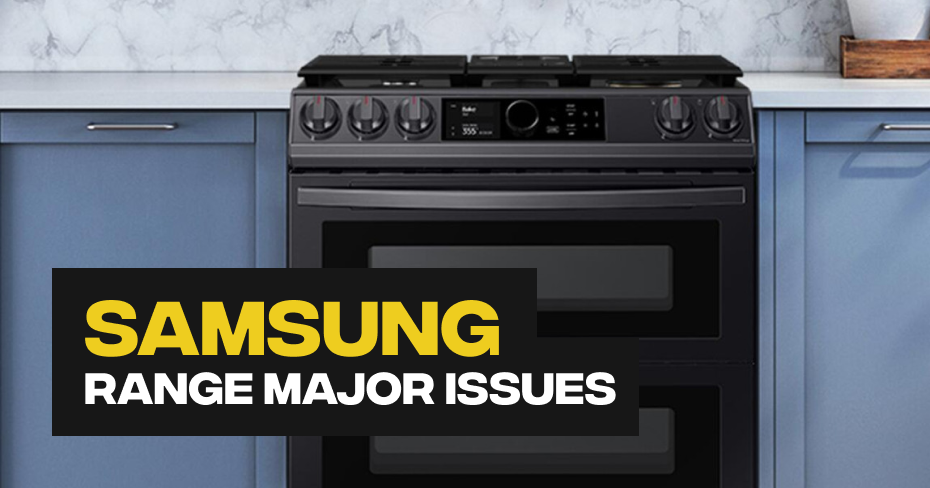
Samsung Range Uneven Heating
Don’t let burned cookies or underdone dinners make you question your chef skills when your oven could be to blame. What do you do when your oven cooks unevenly? First, make sure it’s calibrated correctly so it accurately reflects the set temperature. Determine the reason for a Samsung oven not cooking evenly to restore proper function and your cooking’s reputation.
Troubleshooting A Samsung Oven Not Cooking Evenly
While uneven cooking can happen whether you have a convection vs conventional oven, there are usually several common reasons why. We’ll pinpoint the most likely possibilities for a Samsung oven not cooking evenly, specifying if a quick adjustment or professional repair is necessary.
Common Causes Of Uneven Cooking
Before assessing for a malfunction, Samsung oven troubleshooting begins with use and care errors that can result in uneven cooking.
- Wrong cookware: Dark pans absorb heat more easily than light ones, making burning more likely. Use lighter-colored pans for items that burn easily.
- Incorrect rack position: The oven’s rack may be too close or too far away from the heating element, burning food or leaving it underdone. Check your recipe’s recommendations to make sure your rack is positioned correctly.
- Not pre-heating: Pre-heating the oven ensures that it reaches the right temperature before you start cooking. Failure to pre-heat could mean food is still underdone at the end of the recipe’s cooking time.
- Opening the oven door: Refrain from opening the door while cooking. A closed door keeps heat inside, enabling food to cook completely in its recommended time.
Need To Calibrate Oven Thermostat
An oven thermostat senses the internal temperature, cycling heat on and off as needed. While oven thermostats are usually calibrated during manufacturing, sometimes they need adjusting to more accurately reflect temperature settings.
A simple oven temperature test with one cup of sugar can determine if your oven thermostat needs calibrating. The temperature at which the sugar starts to melt can determine if calibration is necessary. Another simple way to test your oven is to bake a batch of regular biscuits. If you follow the cooking directions but the biscuits come out uneven or undercooked, you may need to calibrate the thermostat.
Wondering how to calibrate a Samsung oven thermostat? The exact steps for your model oven can be found in your user manual. Most ovens can be calibrated in 5 degree increments until they better reflect the set temperature.
Defective Samsung Oven Heating Element
If you have an electric oven, there are two heating elements at the top and bottom that provide heat when cooking. These metal coils contain electrical wires that heat the coil when they receive electrical current. When the heating elements are functioning properly, they produce an even heat and a consistent red glow.
If either heating element is defective, they won’t heat sufficiently, causing a Samsung oven temperature problem. If the top element is defective, food may be underdone on the top while lower element issues can result in food that’s raw on the bottom. While visible damage, like blistering or breakage, often indicates heating element issues, a lack of continuity with multimeter testing can confirm they’re defective. Defective heating elements require replacement.
Faulty Samsung Oven Temperature Sensor
The temperature sensor works with the thermostat and oven control board to regulate temperature. As the oven temperature rises, the sensor’s resistance also rises until the correct temperature is reached, preventing the oven from getting too hot.
If you suspect sensor issues, first make sure it’s properly positioned away from the oven’s walls to accurately measure heat. If the sensor is positioned properly, an ohm monitor should be used to measure its resistance. If the ohm monitor reveals that the sensor is faulty, it must be replaced.
Oven Convection Fan Failure
A convection model Samsung oven not cooking evenly can be due to a fan failure. Convection ovens use a fan to circulate heated air, creating faster and more even cooking. If the fan fails, hot air won’t circulate, resulting in unevenly cooked food.
Convection fan failures can be caused by a faulty fan motor or a blocked or damaged fan blade. If the fan blade doesn’t turn freely, check it for blockages or signs of damage. If the fan blade is damaged or the fan motor has a lack of continuity, they require replacement.
Schedule Appointment